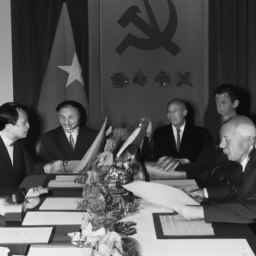Editor's Note: The following is an excerpt from "The Long Game: China's Grand Strategy to Displace American Order" by former Brookings' scholars Erik Brattberg and Evan A. Feigenbaum. China's economic and political footprint has expanded so quickly that many countries, even those with...
In the mid-twentieth century, both China and the Soviet Union adopted approaches in managing their respective economies that shared several striking similarities. These similarities stemmed from their shared ideology and the desire to assert control over their nations' economic development. This article delves into the key commonalities between the economic strategies of these two influential communist powers.
Both China and the Soviet Union aimed to achieve rapid industrialization and transform their agrarian societies into modern, industrialized nations. The Chinese and Soviet leaders recognized the importance of central planning and the role of the state in guiding economic growth. They believed that through meticulous planning, resource allocation, and the nationalization of industries, they could accelerate development and achieve their desired economic outcomes.
One of the fundamental similarities between the two approaches was the establishment of Five-Year Plans. Both China and the Soviet Union formulated comprehensive economic plans spanning five-year periods, outlining specific targets and goals. These plans encompassed various sectors, including industry, agriculture, and infrastructure, and were designed to mobilize resources effectively.
Another common feature was the prioritization of heavy industry over consumer goods production. Both China and the Soviet Union believed that heavy industry formed the foundation for economic growth, as it provided the necessary infrastructure and capital goods required for industrial development. Consequently, resources were disproportionately allocated to heavy industry, leading to a scarcity of consumer goods and a lower standard of living for the general population.
Central to both economic models was the concept of collectivization. In the Soviet Union, collectivization involved the consolidation of individual farms into large, state-controlled collective farms. Similarly, China implemented collectivization through the formation of communes, where agriculture was collectively owned and managed. Both nations aimed to increase agricultural productivity and extract surplus resources for industrialization.
Both China and the Soviet Union utilized central planning to allocate resources and set production targets. The state played a dominant role in economic decision-making, with the government determining prices, quotas, and production levels. Market mechanisms were largely suppressed, and the state exerted significant control over all economic activities.
Furthermore, both nations emphasized self-reliance and pursued policies to reduce dependence on foreign powers. The Soviet Union, under Stalin's leadership, pursued a policy of autarky, aiming to achieve economic independence and reduce reliance on external markets. Similarly, China, under Mao Zedong's leadership, implemented the Great Leap Forward, advocating for local self-reliance and the development of backyard industries.
Despite these similarities, China and the Soviet Union also had notable differences in their economic approaches. China's economy retained a significant degree of decentralization, allowing local governments and enterprises greater autonomy compared to the Soviet Union's highly centralized system.
In conclusion, the mid-twentieth century witnessed China and the Soviet Union adopting similar approaches in managing their economies. Both nations focused on central planning, collectivization, heavy industrialization, and self-reliance. These shared strategies were underpinned by their communist ideologies and the desire to assert control over their economic development. While the similarities were evident, it is essential to acknowledge the differences in implementation, as the Chinese approach retained more elements of decentralization.
